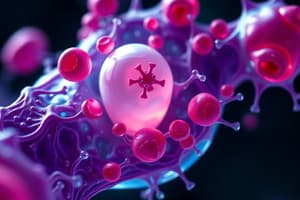Podcast
Questions and Answers
Flashcards are hidden until you start studying
Study Notes
Organelles
- Types of organelles:
- Mitochondria: generate energy for the cell through cellular respiration
- Endoplasmic Reticulum (ER): transports and modifies proteins
- Ribosomes: site of protein synthesis
- Lysosomes: contain digestive enzymes, break down and recycle cellular waste
- Golgi Apparatus: processes and packages proteins and lipids for transport
- Nucleus: contains genetic material (DNA)
- Cytoskeleton: provides structural support and shape to the cell
- Functions of organelles:
- Cellular respiration and energy production
- Protein synthesis and transport
- Cell signaling and communication
- Waste management and recycling
- Structural support and cell division
Human Circulatory System
- Components:
- Heart: pumps blood throughout the body
- Arteries: transport oxygenated blood away from the heart
- Veins: transport deoxygenated blood back to the heart
- Blood vessels: capillaries, arteries, and veins
- Functions:
- Oxygen and nutrient delivery to cells
- Carbon dioxide and waste removal
- Regulation of body temperature
- Maintenance of blood pressure
Cell Division
- Types of cell division:
- Mitosis: somatic cell division, results in two genetically identical daughter cells
- Meiosis: gamete cell division, results in four genetically unique daughter cells
- Stages of cell division:
- Interphase: cell growth and preparation for division
- Prophase: chromatin condenses, nuclear envelope breaks down
- Metaphase: chromosomes align at the center of the cell
- Anaphase: sister chromatids separate
- Telophase: nuclear envelope reforms, chromatin uncondenses
- Cytokinesis: cytoplasm divides, resulting in two daughter cells
Body Systems
- Major body systems:
- Nervous System: controls and coordinates body functions
- Circulatory System: transports oxygen and nutrients, removes waste
- Respiratory System: brings oxygen into the body, removes carbon dioxide
- Digestive System: breaks down and absorbs nutrients
- Immune System: protects the body from pathogens and disease
- Endocrine System: produces and regulates hormones
- Muscular System: moves the body and maintains posture
- Skeletal System: provides structural support and protection
- Interactions between body systems:
- Homeostasis: regulation of internal environment
- Feedback mechanisms: regulation of body functions
Cell Differentiation
- Definition: the process by which cells become specialized to perform specific functions
- Mechanisms:
- Gene expression: specific genes are turned on or off to determine cell fate
- Signal transduction pathways: external signals trigger cell differentiation
- Cellular interactions: interactions with other cells influence cell fate
- Examples:
- Stem cells differentiating into blood cells, nerve cells, or muscle cells
- Epithelial cells differentiating into skin cells, lung cells, or gut cells
Organelles
- Mitochondria are essential for generating energy via cellular respiration.
- The Endoplasmic Reticulum (ER) plays a crucial role in transporting and modifying proteins.
- Ribosomes serve as the site where protein synthesis occurs.
- Lysosomes contain digestive enzymes necessary for breaking down and recycling cellular waste.
- The Golgi Apparatus processes and packages proteins and lipids for cellular transport.
- The nucleus is responsible for housing genetic material (DNA) essential for heredity.
- The cytoskeleton provides structural support and maintains the cell's shape.
Human Circulatory System
- The heart acts as a pump to circulate blood throughout the body.
- Arteries carry oxygenated blood away from the heart to tissues and organs.
- Veins are responsible for returning deoxygenated blood back to the heart.
- The circulatory system includes various blood vessels—capillaries, arteries, and veins.
- Key functions include delivering oxygen and nutrients to cells and removing carbon dioxide and waste.
- The circulatory system helps regulate body temperature and maintain blood pressure.
Cell Division
- Mitosis results in the division of somatic cells, yielding two genetically identical daughter cells.
- Meiosis occurs in gamete cells, producing four genetically unique daughter cells.
- Interphase is characterized by cell growth and preparation for division.
- Prophase involves chromatin condensing and the breakdown of the nuclear envelope.
- In metaphase, chromosomes align at the cell's equatorial plane.
- Anaphase is marked by the separation of sister chromatids toward opposite poles.
- Telophase restores the nuclear envelope and de-condenses chromatin.
- Cytokinesis completes cell division by splitting the cytoplasm into two daughter cells.
Body Systems
- The Nervous System is vital for controlling and coordinating all body functions.
- The Circulatory System ensures the transport of oxygen and nutrients while removing waste products.
- The Respiratory System facilitates the intake of oxygen and the expulsion of carbon dioxide.
- The Digestive System breaks down food and absorbs essential nutrients.
- The Immune System serves to defend the body against pathogens and diseases.
- The Endocrine System is involved in hormone production and regulation.
- The Muscular System enables body movement and maintains posture.
- The Skeletal System provides structural support and protection for vital organs.
- Body systems interact to maintain homeostasis, the regulation of the internal environment.
- Feedback mechanisms play a key role in regulating various body functions.
Cell Differentiation
- Cell differentiation is the process of cells becoming specialized for specific functions.
- Mechanisms include gene expression, where certain genes are activated or silenced to guide cell fate.
- Signal transduction pathways help trigger differentiation in response to external signals.
- Cellular interactions with surrounding cells significantly influence differentiation pathways.
- Examples of differentiation include stem cells developing into blood, nerve, or muscle cells.
- Epithelial cells specialize into skin cells, lung cells, or gut cells based on their roles in the body.
Studying That Suits You
Use AI to generate personalized quizzes and flashcards to suit your learning preferences.




